Where is K-12 Enrollment Headed?
Elusive is the word that comes to mind when describing the trajectory of Virginia’s K-12 public school enrollment trends in recent years.
Prior to the pandemic, the direction of statewide enrollment closely mirrored birth trends and was comparatively predictable. Virginia’s public K-12 enrollment plunged by nearly 40,000 students in the wake of the Coronavirus pandemic, ushering in a new and largely opaque set of enrollment trends.
Two conflicting trends—a steady decline in births over the past 18 years and subtle recovery in school enrollment since the 2020 drop—have made it difficult to predict the future of school enrollment.
Now, the waters may be starting to clear. In this post, I explore how the interplay between these trends might offer clues about where Virginia’s K-12 enrollment is headed.
Expectations vs. Reality
Figure 1 compares how we expected K-12 enrollment to change prior to the pandemic (the dashed orange line) to how it actually changed (solid blue line). It’s safe to say our expectations didn’t quite pan out. Still, it’s worth revisiting where we thought enrollment was headed, as many of the underlying factors behind our pre-pandemic expectations continue to shape the very different path seen today.
Figure 1: Actual K-12 Enrollment and Pre-Pandemic Enrollment Projects for Virginia
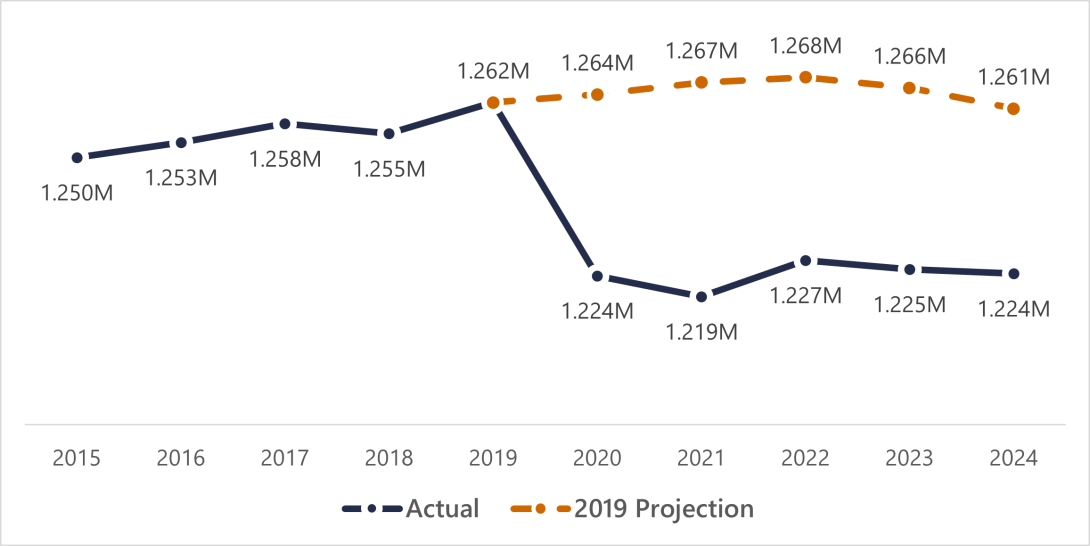
Virginia’s K-12 public enrollment grew across the 2000s and 2010s. But even before the pandemic, we didn’t assume this growth would continue indefinitely. Instead, we expected that enrollment would begin to decline following a peak of nearly 1.27 million students in 2022. Why? The short answer is births.
Births have perhaps the greatest influence on long-term enrollment trends. This is because the number of children born in a given year largely determines the size of the cohort (a group of students who begin school together) that will enter kindergarten five years later.
Figure 2 demonstrates this relationship. Annual births mostly increased in Virginia during the 2000s, peaking at 108,416 births in 2007. Kindergarten enrollment followed with a five-year lag, growing across the mid-to-late 2000s and peaking at 97,001 students in 2012. Factors such as in-migration and transfers into public schools caused these larger-than-average cohorts to grow as they progressed into higher grades, which drove the statewide K-12 growth in the years leading up to the pandemic.
Figure 2: Births and Public Kindergarten Enrollment in Virginia
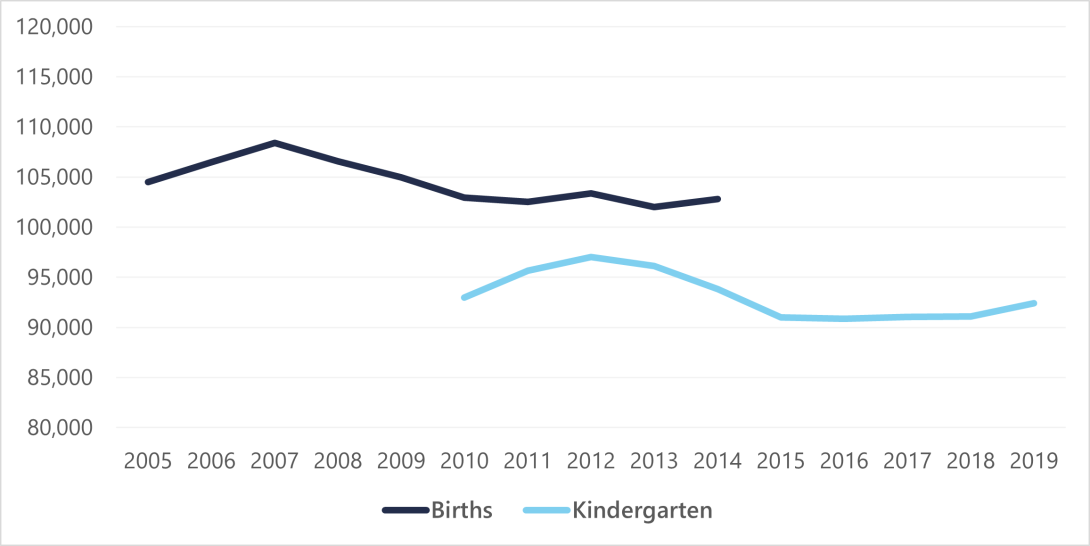
Annual births fell in 2008 and continued to fall into 2019. As a result, the size of incoming cohorts began to shrink. The proliferation of these smaller “post-2012” cohorts quietly eroded the foundation of the state’s K-12 enrollment. By 2019, cracks were starting to show as K-5 enrollment had decreased by nearly 11,000 students compared to its peak in 2014. Despite these losses, K-12 enrollment mostly grew during this period as the larger, pre-2013 cohorts swelled middle school enrollment.
Figure 3: Percent Change in Enrollment, Grades K-5 and Grades 6-8 in Virginia
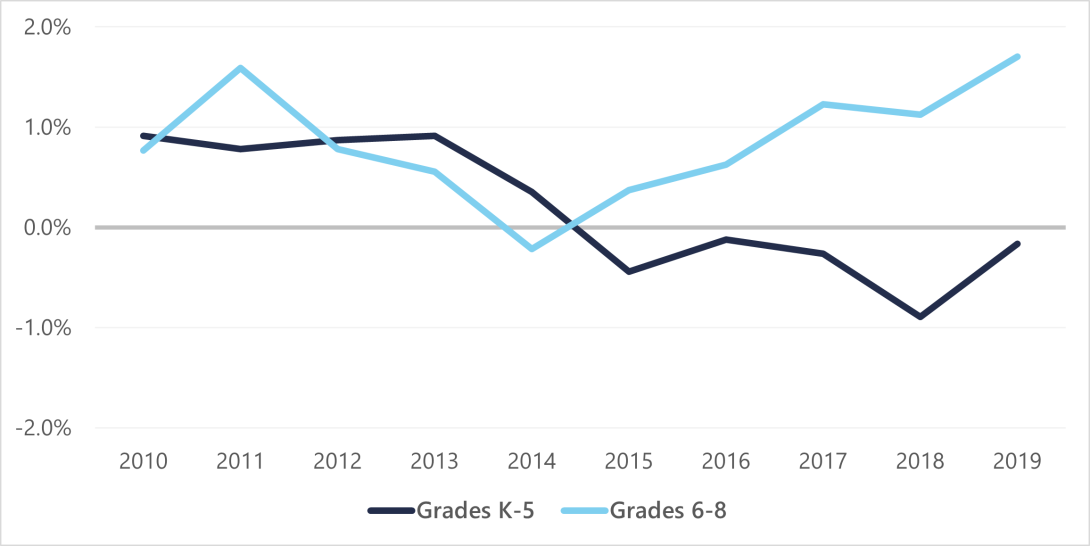
Regardless of the pandemic, enrollment decline in the 2020s seemed inevitable. Smaller cohorts continued to enter Virginia schools and would, over time, start to replace the larger pre-2013 cohorts that had been sustaining K-12 enrollment.
Hidden Recovery
By now, the pandemic’s dramatic effect on Virginia’s public school enrollment is well known. Years later, K-12 enrollment has yet to show meaningful recovery, with 2021-2024 fall counts trailing 2019 figures by about 40,000 students.
A closer look at cohort-level trends, however, reveals a more nuanced picture: some cohorts have fully or partially rebounded, even as K-12 enrollment continues to flounder.
Cohorts that began school from 2015 to 2020 were disproportionately impacted by the 2020 enrollment shock. The 2015-2019 cohorts lost about 17,000 students as they progressed from grades K-4 in 2019 into grades 1-5 in 2020. In addition, the 2020 cohort made up Virginia’s smallest kindergarten class in at least the past decade, counting 11,821 fewer students than the previous year’s class.
The 2015-2020 cohorts entered grades 4-9 in the fall of 2024. These cohorts added a combined 33,501 students over the past four school years (2021-2024), strongly indicating a return to Virginia’s public schools. Figure 4 shows how growth in each of these cohorts contributed to this recovery. The 2020 cohort—the smallest to enter Virginia schools in more than a decade—led the way in 2021, adding 6,594 students as it progressed from kindergarten into the first grade. Growth in 2022 and 2023 was more evenly spread across these cohorts. As is typical, the 2015 cohort (enrolled in the 5th grade in 2020) added 8,752 students as it progressed from the 8th grade in 2023 into the ninth grade in 2024.
Figure 4: Annual Enrollment Growth for 2015-2020 Cohorts
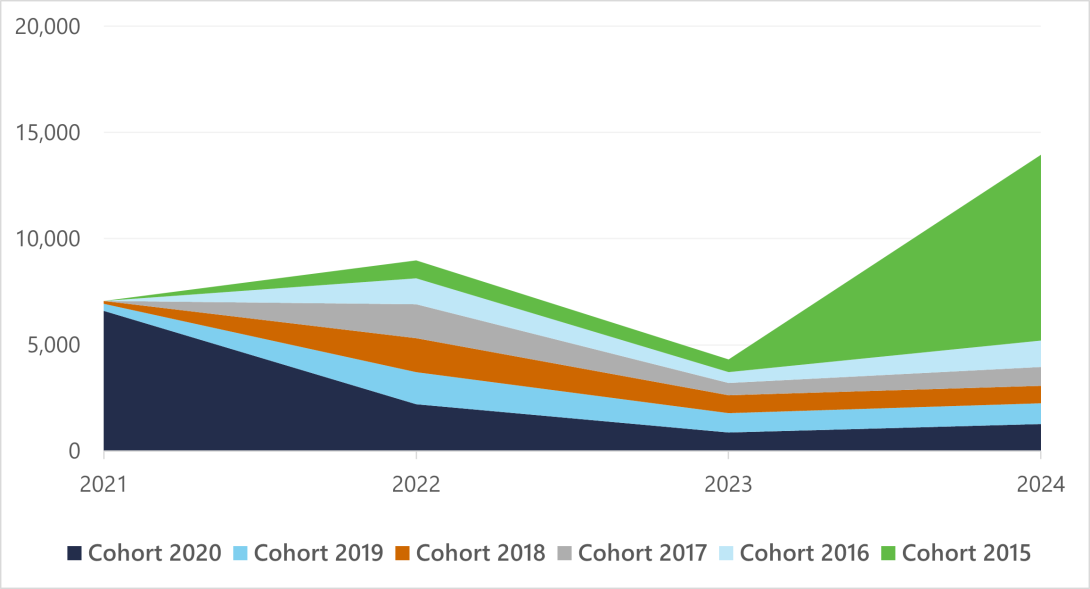
Figure 5 illustrates how these cohorts are gradually returning to their pre-pandemic (2019) class sizes. For example, the 2018 cohort lost 4,515 students as it entered the second grade in 2020. By the fall of 2024, however, it trailed its pre-pandemic class size by 1,099 students. The 2019 cohort and, to a much greater extent, the 2015 cohort exceeded their pre-pandemic class sizes in 2024.
Figure 5: Change in 2015-2019 Cohort Size since 2019
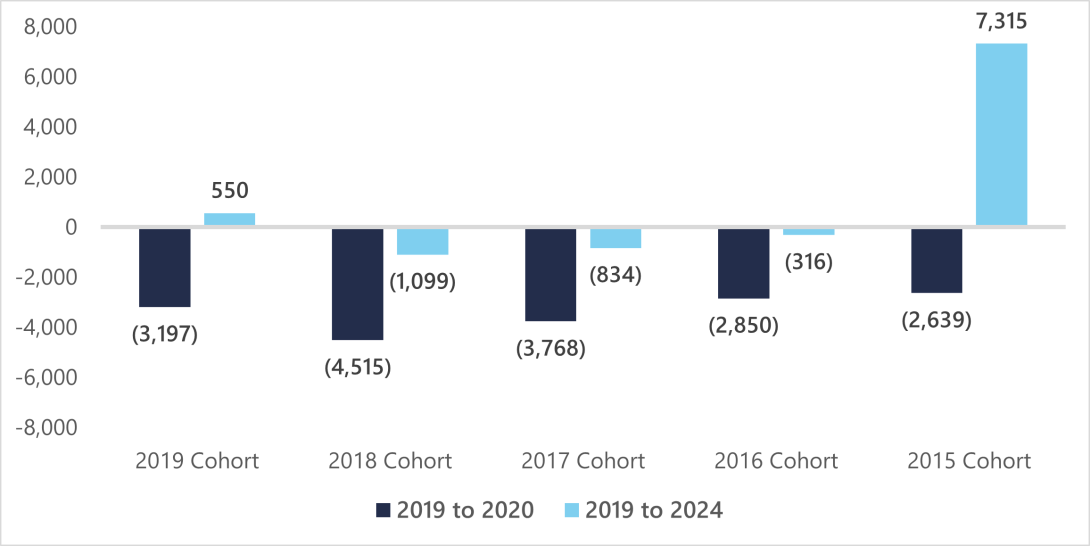
While the 2020 cohort lacks a true pre-pandemic benchmark, we can approximate its recovery by comparing it to the 2019 kindergarten class. The 2020 cohort began kindergarten with 11,821 fewer students than the 2019 kindergarten class. By 2024, that gap had narrowed to 905 students.
The Bigger Picture
Figure 6 compares enrollment for grades K-5, 6-8, and 9-12 from 2019 to 2024. The patterns shown here mark a reversal in how the state’s enrollment changed before the pandemic. Before 2020, enrollment decline originated from grades K-5 and was offset by growth in grades 6-8. Recovery in 2015-2020 cohorts drove K-5 enrollment growth in 2022 and has helped keep it stable into 2024. Meanwhile, middle school enrollment has faltered as the smaller cohorts that began school after 2012 have saturated this grade band. A similar pattern is emerging in grades 9-12, where enrollment declined from 2023-2024.
Figure 6: Enrollment by Grade Bands in Virginia
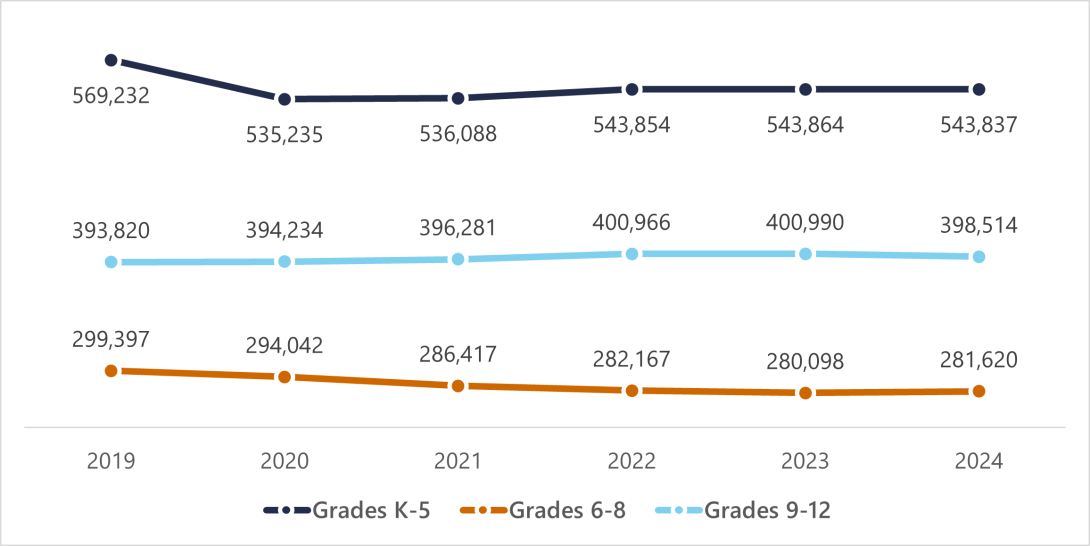
Figure 7 compares kindergarten and 12th grade enrollment. As mentioned throughout this post, kindergarten enrollment began to decline in 2013 and has continued into 2024. Meanwhile, 12th grade enrollment has mostly grown as the larger cohorts that started school prior to 2013 have begun to graduate.
Figure 7: Kindergarten and 12th Grade Enrollment in Virginia
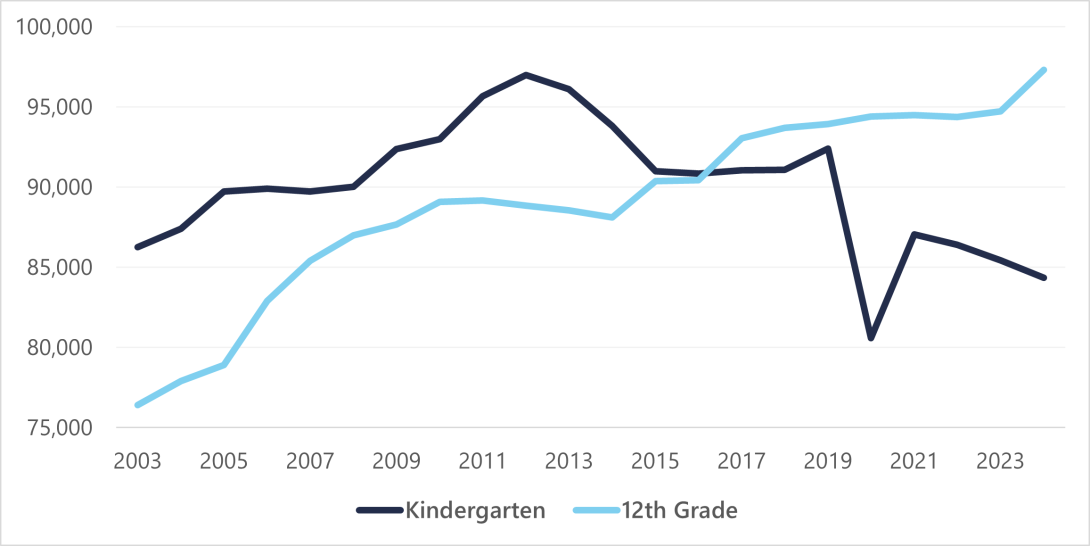
In the spring of 2025, Virginia public schools graduated their largest cohort—the same cohort that made up the largest kindergarten class in 2012. This marks an important milestone in these dynamics as the first of the progressively smaller cohorts that began school after 2012 will enter the 12th grade. At this point, the gradual, bottom-up decline that began in 2013 will have fully worked its way through the K-12 system.
Looking Ahead
The Demographics Research Group will release a new round of statewide enrollment projections in January of 2026. The trends discussed in this blog post will shape Virginia’s future public K-12 enrollment.
Virginia’s K-12 enrollment has shown little direction in recent years, but steady decline now seems likely. The 2015-2020 cohorts (those enrolled in grades K-5 in 2020) are recovering after experiencing the brunt of the 2020 enrollment shock, with two of these cohorts exceeding their pre-pandemic class size. This recovery mostly halted K-5 enrollment losses since 2021. By fall of 2025, however, only one of these cohorts will remain in elementary school. In addition, kindergarten class sizes and annual births continue to decline. This nearly guarantees that K-5 enrollment decline will resume, likely at a faster pace.
A continued, if not sharper, decline is also likely in middle and high school enrollment. Each year since 2013, the larger cohorts that once stabilized K-12 enrollment have slowly given way to smaller ones. After 2020, the cascading decline that began in grades K-5 became evident in grades 6-8 as the larger pre-2013 cohorts entered high school. This pattern is now taking root in grades 9-12, especially as the last and largest of the pre-2013 cohorts graduated in the spring of 2025. While continued recovery in 2015-2020 cohorts could soften losses, it seems inevitable that nearly each advancing cohort will be replaced by a smaller one in the years ahead.


